 Cylindrical mate
Cylindrical mate
![]()
![]()
![]()
Mate two entities allowing translational movement along the Z axis and rotational movement about the Z axis (Tz, Rz). Begin by creating Mate connectors on each entity, or use the implicit Mate connectors visible upon hover.
The first Mate connector selected (implicit or explicit) serves as the translational and rotational point and the second Mate connector selected (implicit or explicit) serves as the stationary point.
The Cylindrical and Pin Slot mates have two degrees of freedom. The Cylindrical mate allows translation along and rotation about the Z axis.
Start a Cylindrical mate. In this example, a recoil grip needs to move along the primary axis to reflect the motion of pulling. The first selected point is the bottom face of the recoil grip, and the second point is the top face of the cord inlet on the recoil cover.
Animate to see the grip rotate and translate along the Z axis. Without limits, it moves freely in both directions along the axis. To restrict the movement so that it does not surpass the recoil cover, use Limits.
The Pin Slot mate allows for rotation about the Z axis and translation along the X axis.
Start a Pin Slot mate. In this example, the Drill has a switch that needs to move up and down along a slot. The first selected point of a Pin Slot mate is the slot, and the second point is the pin. This is reflected in the mate connectors’ field order. If you accidentally select the pin first, reorder the field so that the slot is at the top. Click Reorder items and then use the handles on the right side to rearrange. Click Done to finalize the reorder.
First, select the bracket’s slot. Move the cursor to the center of the slot and click to place the first mate connector. Next, select the corresponding point on the switch to place the second mate connector. Toggle the Reorient primary axis arrow if necessary to get the proper alignment.
Check Limits to restrict how far the Pin Slot mate translates and rotates. To keep the switch within the slot, set the X minimum distance to half the slot length in the negative and enter a value for the maximum distance of half the slot length in the positive. Because the switch should not rotate, set the Z minimum and maximum distances to 0.
Animate to view the movements of the mate within the defined limits.
Steps
-
Click
 .
.
-
Select two Mate connectors (implicit or explicit).
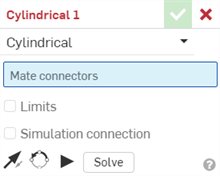
- To impose limits on the movement of the mate, click Limits and supply minimum distances for the axis of both Mate connectors.
Limits are visualized in the graphics area as dashed lines with bars at the ends. The dashed lines represent the direction and distance of the movement and the solid lines represent the limit.
If a Mate has one or more applied limits, the Mate limit indicator icon
 is visible to the right of the Mate in the Mate Features list.
is visible to the right of the Mate in the Mate Features list.
- Click the entity to access the manipulator.
- Click and drag the various manipulator handles to see which motions are allowed; notice that only translational movement along the Z axis and rotational movement about the Z axis is allowed (Tz, Rz).
Editing a Mate connector
Once a Mate is created between two explicit or implicit Mate connectors, you can edit either Mate connector:
-
Open the Mate dialog. In the example below, the Fastened mate is used as an example. The process is similar for all Mates, except Tangent mate which does not use Mate connectors.
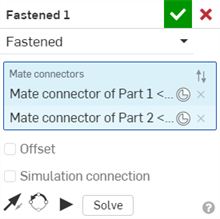
-
Click the Mate connector icon (
 ). The Mate connector dialog opens, where you can edit the mate connector's origin type, origin entity, alignment, location, primary axis direction, and secondary axis orientation:
). The Mate connector dialog opens, where you can edit the mate connector's origin type, origin entity, alignment, location, primary axis direction, and secondary axis orientation:
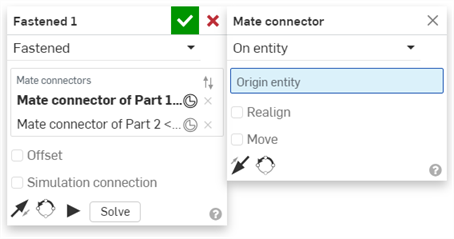
Editing Mate connectors from the Mate dialog is limited to implicit or explicit connectors located in the current Assembly. Mate connectors from Part Studios, subassemblies, or linked documents must be edited in their original location.
Steps
-
Tap the Cylindrical mate icon (
 ).
).
- Confirm that Cylindrical is selected in the Mate type field.
- Select two Mate connectors (implicit or explicit) to use.
- Optionally, tap Limits to set distance limits for movement.
-
Optionally, tap
 to Flip the primary axis, Z orientation of the instances.
to Flip the primary axis, Z orientation of the instances.
-
Optionally, tap
 to Reorient the secondary axis; rotate the quadrant orientation (in the XY plane) of the instances by 90 degrees at a tap.
to Reorient the secondary axis; rotate the quadrant orientation (in the XY plane) of the instances by 90 degrees at a tap.
- Tap checkmark.
Touch and drag OR use the Triad Manipulator to move one of the parts. Notice that only translational movement along the Z axis and rotational movement about the Z axis is allowed (Tz, Rz).

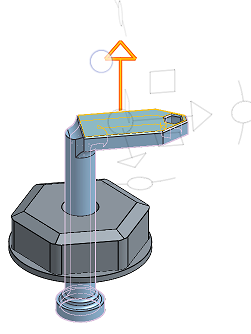
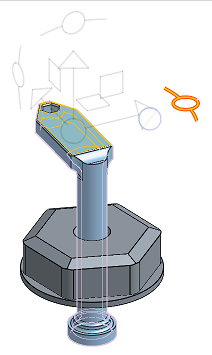
Steps
-
Tap
 .
.
- Confirm that Cylindrical is selected in the Mate type field.
- Select two Mate connectors (implicit or explicit) to use.
- Optionally, tap Limits to set distance limits for movement.
-
Optionally, tap
 to Flip the primary axis, Z orientation of the instances.
to Flip the primary axis, Z orientation of the instances.
-
Optionally, tap
 to Reorient the secondary axis; rotate the quadrant orientation (in the XY plane) of the instances by 90 degrees at a tap.
to Reorient the secondary axis; rotate the quadrant orientation (in the XY plane) of the instances by 90 degrees at a tap.
- Tap checkmark.
Touch and drag OR use the Triad Manipulator to move one of the parts. Notice that only translational movement along the Z axis and rotational movement about the Z axis is allowed (Tz, Rz).


